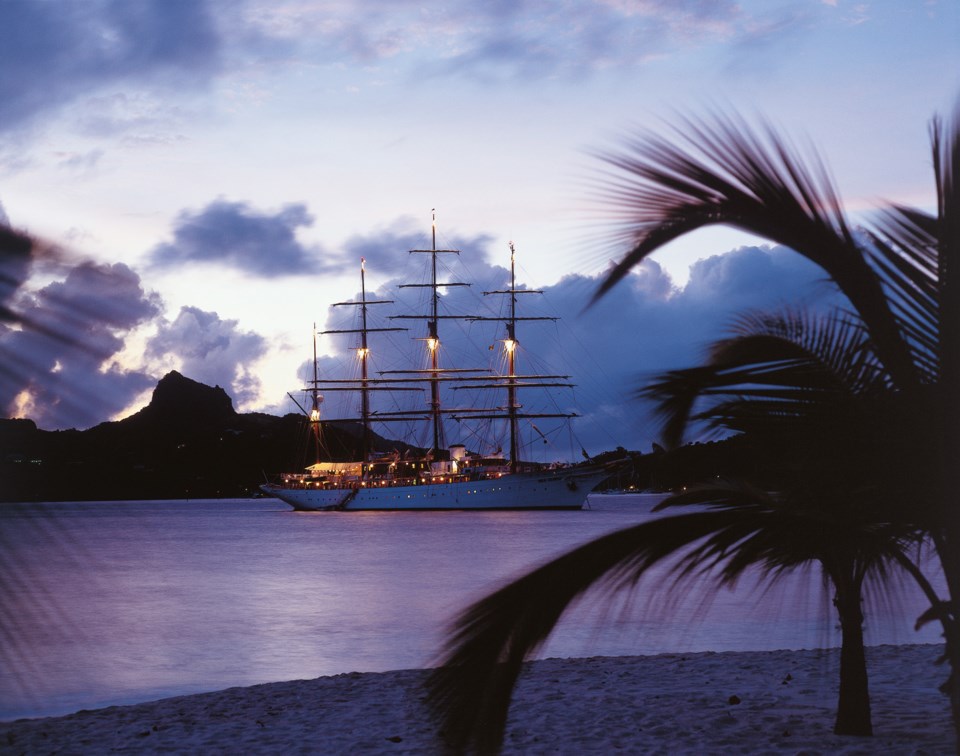Years ago I met a bloke on a river boat in India. He had made a fortune in Calcutta and was cruising the world in style – and he had no doubt about his favourite ship. “Sea Cloud. Nothing like it.”
So it happened that one sunny day later a bus dropped me on a grubby little dock in Puerto Limon, Costa Rica, and there she was – a big four-masted barque (sailing ship) with towering masts and looking absolutely like nothing else in the world.
My companions and I on the bus would fill Sea Cloud, because her capacity is just 65, slightly under the 6,000 or so on cruise ships of a different kind.
Sea Cloud was launched 84 years ago at a time of elegant liners, just months before the greatest of them all, the Normandie, when the richest men competed to build the biggest yachts with gimmicks to amuse prohibition-era guests, such as bars that glided from behind library walls.
Sea Cloud, however, was no gin palace, and belonged to a woman, American cereal heiress Marjorie Merriweather Post, who simply went for the best.
The yard was Krupps at Kiel, the
hull was steel, the decks mahogany and teak, and the masts the height of a 20-storey building. Sea Cloud was an ocean-going sailing ship capable of voyages of 20,000 miles, with provisions for six months.
Nevertheless, she was fitted out with an elegant interior with classical French furniture, marble fireplaces and bathrooms, antiques, oriental carpets and oil paintings – all of it assembled beforehand for the owner’s approval in a warehouse in Brooklyn. Her four masts carried 29 sails and 32,000 square-feet of canvas, and when the wind could not deliver, Sea Cloud had the world’s first high-performance diesel-electric power plant good for 14 knots.
Sea Cloud carried Hollywood stars and top politicians, served in the coastguard during the Second World War and, bizarrely, was later swapped for a Vickers Viscount aircraft, the new owner being Trujillo, the dictator of the Dominican Republic. Sea Cloud then spent time in Los Angeles, where Trujillo’s playboy son used her to party with Kim Novak, Zsa Zsa Gabor and Joan Collins.
It was downhill from there, with Sea Cloud laid up in Panama, but she was then rescued by a group of German businessmen in 1978. A huge refurbishment followed, additional cabins cleverly added to make a cruise operation viable, and off she sailed to amaze the world again.
Sea Cloud now cruises the Mediterranean in the summer and the Caribbean in the winter, her voyages much sought after by well-travelled, affluent (you have to be to afford it) lovers of the sea and ships.
It is a world rarely sullied by grubby travel writers, so when the opportunity arose, I crossed an ocean to be there. Our voyage was 12 days, calling at Nicaragua, Honduras, Belize, Cozumel and Cuba.
With the sails set it was a thing of beauty. Passengers stood on deck in wonder as the young sailors swarmed up the rigging. This was an experience of times long gone, of sleek clippers racing around Cape Horn like unstoppable express trains, when a man overboard was not uncommon, but immediately given up for lost. Sea Cloud has had its moments, such as one trans-Atlantic crossing when nine sails blew out in 30 minutes.
The wheelhouse was open most of the time and we even had a visit to the engine room, the former only possible in the best ships, and the latter off limits other than on the paddle-steamer Waverley and a few other classics. Dining was in the gorgeous, wood-paneled salon and the meals and service as good as you’ll find anywhere at sea. I also liked meals on the Lido deck, where the buffet could be lobster or delicious roast lamb. Wine and beer came with every meal, but not spirits. On the other hand there was no charge to see the doctor on board.
Once on every cruise, passengers in the original cabins are asked to leave their doors open, which most do, so others can stroll, wide-eyed, through the gilded doors and see, such as, the owner’s suite, which has swan-shaped gold faucets – chosen because gold is easier to clean than brass.
Ports of call were generally relaxing, with plenty of excursion options as well as beach time, with the highlight being the entrance to our arrival port, Havana. Sails were furled for the narrow passage past the towering fort, and a poignant moment it was, for the superb voyage was almost over.
And so we left with a thought
from English poet John Masefield:
“I must go down to the seas again,
to the lonely sea and the sky,
And all I ask is a tall ship
and a star to steer her by...”
Everyone on board would agree.
This was the real thing.
For more information, visit seacloud.com. David Wishart was an invited guest of the Sea Cloud.
dcwishart@icloud.com



